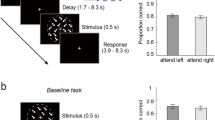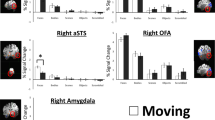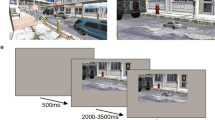Abstract
Contrasting theories of visual attention emphasize selection by spatial location1, visual features (such as motion or colour)2,3,4 or whole objects5,6. Here we used functional magnetic resonance imaging (fMRI) to test key predictions of the object-based theory, which proposes that pre-attentive mechanisms segment the visual array into discrete objects, groups, or surfaces, which serve as targets for visual attention5,6,7,8,9. Subjects viewed stimuli consisting of a face transparently superimposed on a house, with one moving and the other stationary. In different conditions, subjects attended to the face, the house or the motion. The magnetic resonance signal from each subject's fusiform face area10, parahippocampal place area11 and area MT/MST12 provided a measure of the processing of faces, houses and visual motion, respectively. Although all three attributes occupied the same location, attending to one attribute of an object (such as the motion of a moving face) enhanced the neural representation not only of that attribute but also of the other attribute of the same object (for example, the face), compared with attributes of the other object (for example, the house). These results cannot be explained by models in which attention selects locations or features, and provide physiological evidence that whole objects are selected even when only one visual attribute is relevant.
This is a preview of subscription content, access via your institution
Access options
Subscribe to this journal
Receive 51 print issues and online access
$199.00 per year
only $3.90 per issue
Buy this article
- Purchase on Springer Link
- Instant access to full article PDF
Prices may be subject to local taxes which are calculated during checkout



Similar content being viewed by others
References
Posner,M. I. Orienting of attention. Q. J. Exp. Psychol. 32, 3–25 (1980).
Treisman,A. M. Strategies and models of selective attention. Psychol. Rev. 76, 282–299 (1969).
Corbetta,M. et al. Attentional modulation of neural processing of shape, color, and velocity in humans. Science 248, 1556–1559 (1990).
Wolfe,J. M., Cave,K. R. & Franzel,S. L. Guided search: an alternative to the feature integration model for visual search. J. Exp. Psychol. Hum. Percept. Perf. 15, 419–433 (1989).
Duncan,J. Selective attention and the organization of visual information. J. Exp. Psychol. Gen. 113, 501–517 (1984).
He,Z. J. & Nakayama,K. Visual attention to surfaces in three-dimensional space. Proc. Natl Acad. Sci. USA 24, 11155–11159 (1995).
Vandenberghe,R. et al. Attention to one or two features in left or right visual field: a positron emission tomography study. J. Neurosci. 17, 3739–3750 (1997).
Roelfsema,P. R., Lamme,V. A. & Spekreijse,H. Object-based attention in the primary visual cortex of the macaque monkey. Nature 395, 376–381 (1998).
Driver,J., Baylis,G. C., Goodrich,S. J. & Rafal,R. D. Axis-based neglect of visual shapes. Neuropsychologia 32, 1353–1365 (1994).
Kanwisher,N., McDermott,J. & Chun,M. The fusiform face area: A module in human extrastriate cortex specialized for the perception of faces. J. Neurosci. 17, 4302–4311 (1997).
Epstein,R. & Kanwisher,N. A cortical representation of the local visual environment. Nature 392, 598–601 (1998).
Tootell,R. B. et al. Functional analysis of human MT and related visual cortical areas using magnetic resonance imaging. J. Neurosci. 15, 3215–3230 (1995).
Eriksen,B. A. & Eriksen,C. W. Effects of noise letters upon the identification of target letters in a nonsearch task. Percept. Psychophys. 16, 143–149 (1974).
Driver,J. & Baylis,G. C. Movement and visual attention: The spotlight metaphor breaks down. J. Exp. Psychol. Hum. Percept. Perf. 15, 448–456 (1989).
Rosen,B. R., Buckner,R. L. & Dale,A. M. Event-related functional MRI: Past, present, and future. Proc. Natl Acad. Sci. USA 95, 773–780 (1998).
O'Craven,K. M., Rosen,B. R., Kwong,K. K., Treisman,A. & Savoy,R. L. Voluntary attention modulates fMRI activity in human MT-MST Neuron 18, 591–598 (1997).
Beauchamp,M. S., Cox,R. W. & DeYoe,E. A. Graded effects of spatial and featural attention on human area MT and associated motion processing areas. J. Neurophys. 78, 516–520 (1997).
Treue,S. & Trujillo,J. C. M. Feature-based attention influences motion processing in macaque visual cortex. Nature 399, 575–579 (1999).
Hillyard,S. A. & Munte,T. F. Selective attention to color and location: An analysis with event-related brain potentials. Percept. Psychophys. 36, 185–198 (1984).
Courtney,S. M., Ungerleider,L. G., Keil,K. & Haxby,J. V. Transient and sustained activity in a distributed neural system for human working memory. Nature 386, 608–611 (1997).
Salzman,C. D. & Newsome,W. T. Neural mechanisms for forming a perceptual decision. Science 264, 231–237 (1994).
Mangun,G. & Hillyard,S. A. Allocation of visual attention to spatial location: Tradeoff functions for event related brain potentials and detection performance. Percept. Psychophys. 47, 532–550 (1990).
Brefczynski,J. A. & DeYoe,E. A. A physiological correlate of the ‘spotlight’ of visual attention. Nature Neurosci. 4, 370–374 (1999).
Somers,D. C., Dale,A. M., Seiffert,A. E. & Tootell,R. B. Functional MRI reveals spatially specific attentional modulation in human primary visual cortex. Proc. Natl Acad. Sci. USA 96, 1663–1668 (1999).
Gandhi,S. P., Heeger,D. J. & Boynton,G. M. Spatial attention affects brain activity in human primary visual cortex. Proc. Natl Acad. Sci. USA 96, 3314–3319 (1999).
Valdes-Sosa,M., Bobes,M., Rodriguez,V. & Pinilla,T. Switching attention without shifting the spotlight: Object-based attentional modulation of brain potentials. J. Cogn. Neurosci. 10, 137–151 (1998).
Desimone,R. & Duncan,J. Neural mechanisms of selective visual attention. Annu. Rev. Neurosci. 18, 193–222 (1995).
Kastner,S., Pinsk,M. A., De Weerd,P., Desimone,R. & Ungerleider,L. G. Mechanisms of directed attention in the human extrastriate cortex as revealed by functional MRI. Neuron 22, 751–761 (1999).
Treisman,A. M. & Gelade,G. A feature-integration theory of attention. Cogn. Psychol. 12, 97–136 (1980).
Qian,N., Andersen,R. A. & Adelson,E. H. Transparent motion perception as detection of unbalanced motion signals. I. Psychophysics. J. Neurosci. 14, 7357–7566 (1994).
Acknowledgements
We thank B. Rosen and others at the MGH-NMR Center for support; H. Wyatt for consultation on eye movements; and B. Anderson, J. Driver, R. Epstein, J. Mausell, M. Potter, G.Rainer, F. Tong, A. Wagner and members of our lab for comments on the manuscript.
Author information
Authors and Affiliations
Corresponding author
Supplementary information
Rights and permissions
About this article
Cite this article
O'Craven, K., Downing, P. & Kanwisher, N. fMRI evidence for objects as the units of attentional selection. Nature 401, 584–587 (1999). https://doi.org/10.1038/44134
Received:
Accepted:
Issue Date:
DOI: https://doi.org/10.1038/44134
This article is cited by
-
Foundations of human spatial problem solving
Scientific Reports (2023)
-
Feature Attention as a Control Mechanism for the Balance of Speed and Accuracy in Visual Search
Computational Brain & Behavior (2023)
-
Hippocampal convergence during anticipatory midbrain activation promotes subsequent memory formation
Nature Communications (2022)
-
Comparing the temporal dynamics and efficacy of task-relevant and task-irrelevant memory-driven attention
Cognitive Processing (2022)
-
On the reliability of behavioral measures of cognitive control: retest reliability of task-inhibition effect, task-preparation effect, Stroop-like interference, and conflict adaptation effect
Psychological Research (2022)
Comments
By submitting a comment you agree to abide by our Terms and Community Guidelines. If you find something abusive or that does not comply with our terms or guidelines please flag it as inappropriate.



